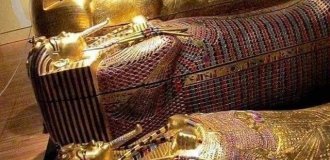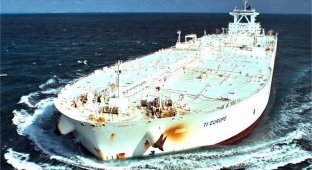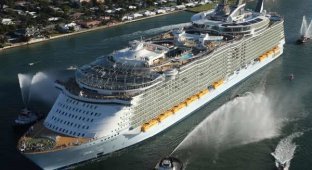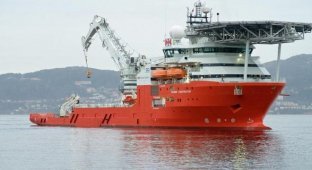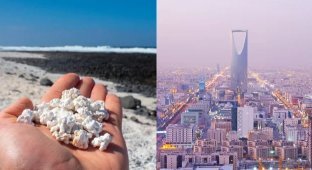He could easily take on the Empire State Building and the Eiffel Tower. But its cargo is $195 million worth of oil. He has outlived several owners and is already on his fourth name. They hit him with rockets and cut him in half. And yet, for more than 20 years it remains the largest ship on the planet.


The history of this ship began in Japan in 1976 (some sources for some reason indicate 1975) at the shipyards of Sumitomo Heavy Industries.
Then our hero was born under the modest serial number “1016” and was handed over to a certain Greek shipowner, who gave the tanker its first real name “Seawise Giant”.
It’s interesting that the tanker wasn’t that big back then. Almost. Its carrying capacity was 480 thousand tons (typical modern supertankers hold 280 thousand tons).

She sailed for three years, and very soon the ship was sold to a new owner, who ordered its enlargement. Japanese shipbuilders cut and extended the ship, which took a lot of time.
Finally, in 1981, the tanker was ready for service again. Welded additional sections of the hull increased its deadweight (capacity) to 564 thousand 763 tons of oil, otherwise - to 658 thousand 362 cubic meters.

By the way, this oil is separated from the sea by only one steel board 3.5 centimeters thick.
The total displacement of the monster after reconstruction reached 825 thousand 614 tons, which, along with its size, made it the largest ship ever sailed on Earth.

Dimensions. This must be imagined, because there are no suitable photographs that would allow one to feel the scale of the supertanker.
Its length is 458.45 meters, width is 68.86 meters (other sea vessels have a shorter length), and its draft under load is 24.61 meters.
Not only the Titanic, but also modern cruise giants that surpass the Titanic in all sizes are simply not impressive compared to this tanker. Turbines with a capacity of 50 thousand horsepower accelerate the tanker at full load to 13 knots (approximately 24 kilometers per hour).
Interestingly, the ship's crew consists of only 40 people.

Obviously, a tanker of this size provides the opportunity to deliver black gold to its destination very economically (per ton of oil).
True, here's the problem - with a full load, this tanker cannot pass through the English Channel, the Suez and Panama Canals, nor can it moor in most major ports of the world.
It would seem that, given its geometric dimensions, it could perform this trick. But safety plays a big role here.

Think about it: the giant’s braking distance is 10.2 kilometers, and its turning circle exceeds 3.7 kilometers! So, among other ships scurrying around these waters, this supertanker is like a bull in a china shop.
When the tanker needs to be brought to the oil terminal, it is taken in tow and pulled very, very slowly. It is easy to imagine what can happen if there is an error in maneuvering a ship weighing almost a million tons.
During its life, the supergiant tanker changed several owners and changed its name more than once - first to Happy Giant, then to Jahre Viking.

Not long ago, the tanker visited dry docks in Dubai, received new equipment and turned into a so-called “Floating Storage and Offloading unit” for oil. At the same time, the ship was renamed Knock Nevis. The ship is owned by Norwegians and operates in Qatari waters.

Interestingly, in 1986, an Iraqi fighter fired an Exocet anti-ship missile at a unique tanker, which was then almost in the Persian Gulf (or rather, in the Strait of Hormuz, lying between Iran and the UAE, leading into the Gulf).
The tanker did not die, but was disabled. Only in 1989 was it revived by Singapore ship repairers, replacing 3.7 thousand tons of crumpled steel.









